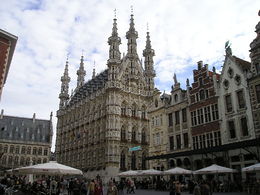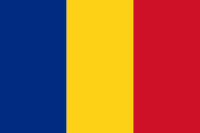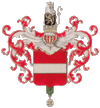Leuven
| Leuven | ||||||
|---|---|---|---|---|---|---|
 |
||||||
|
||||||
 |
||||||
 Leuven
Location in Belgium
|
||||||
| Sovereign state | ||||||
| Region | ||||||
| Community | ||||||
| Province | ||||||
| Arrondissement | Leuven | |||||
| Coordinates | ||||||
| Area | 56.63 km² | |||||
| Population – Males – Females – Density |
90,706 (2006-01-01) 49.32% 50.68% 1602 inhab./km² |
|||||
| Age distribution 0–19 years 20–64 years 65+ years |
(01/01/2006) 19.59% 63.45% 16.95% |
|||||
| Foreigners | 9.43% (01/07/2005) | |||||
| Unemployment rate | 8.67% (1 January 2006) | |||||
| Mean annual income | €15,183/pers. (2003) | |||||
| Mayor | Louis Tobback (SP.A) | |||||
| Governing parties | SP.A-Vl.Pro, CD&V-N-VA | |||||
| Postal codes | 3000, 3001, 3010, 3012, 3018 | |||||
| Area codes | 016 | |||||
| Website | www.leuven.be | |||||
Leuven (Dutch, pronounced [ˈløːvə(n)]; French: Louvain, pronounced [lu'vɛ̃], often used in English, German: Löwen) is the capital of the province of Flemish Brabant in the Flemish Region, Belgium. It is located 26 kilometers (16 miles) east of Brussels, with as other neighbouring cities Mechelen, Aarschot, Tienen, and Wavre.
The township comprises the historical city of Leuven and the former municipalities of Heverlee, Kessel-Lo, a part of Korbeek-Lo, Wilsele and Wijgmaal.
It is home to Anheuser-Busch InBev, the world's largest brewing group and one of the top five largest consumer goods companies in the world; and to the Katholieke Universiteit Leuven, the largest and oldest university of the Low Countries and the oldest Catholic university still in existence.
Contents |
History

The earliest mention of Leuven ("Loven") is from 891 when a Viking army was defeated by the Frankish king Arnulf of Carinthia (see: Battle of Leuven). According to the city legend, its red-white-red colours depict the blood-stained shores of the river Dijle after this battle.
Situated at this river and near the stronghold of the Dukes of Brabant, Leuven became the most important centre of trade in the duchy between the 11th and 14th centuries. A token of its former importance as a centre of cloth manufacture, is nicely reflected in the typical Leuven linen cloth, known in late 14th-15th century texts as lewyn (other spellings: Leuwyn, Levyne, Lewan(e), Lovanium, Louvain)[1].
In the 15th century a new golden era began with the founding of the Catholic University of Leuven, in 1425: it is now the largest and oldest university in the Low Countries.
In the 18th century Leuven became even more important as a result of the flourishing of the brewery now named InBev. In the 19th century the city became an industrial but also an intellectual centre. Around 1885-1890 the economic crisis forced hundreds of citizens to emigrate to Latin America (Argentina), the USA and Canada.
On November 13, 1895 films were projected by Charles Moisson, an engineer working for the French Lumière brothers, using their latest invention the cinematograph. The projection was held at the Catholic University of Leuven for an association of industrialists, scientists and photographers, it was the second one ever projected outside France at that time. In the same period Thomas Alva Edison's Kinetoscope and Kinetophone also came to this city. In the coming years films were brought by travelling showmen to the fairs and the annual city feasts, or for showing in local music halls and public halls. Between 1908 and 1914 there were about ten cinemahalls active in the city which had then about 40,000 inhabitants. Among these a special one dedicated to Kinemacolor films was established in 1912.[2][3][4].

In the 20th century, both World Wars inflicted major damage to the city. Upon German entry in World War I, the town was heavily damaged due to the German Schrecklichkeit policy. The Germans shot the mayor, university rector and all the city's police officers.[5][6] The university library was deliberately destroyed by the German army on August 25, 1914, using petrol and incendiary pastilles. Hundreds of thousands of irreplaceable volumes and Gothic and Renaissance manuscripts were lost.[7] The world was outraged over this and the library was completely rebuilt after World War I with American charity funds and German war indemnities. Thousands of its citizens fled to the countryside, to other cities but also to the Netherlands, England and France. A number of them were also deported by the Germans to Germany. The sack of Leuven became an element in the propaganda war. One of the films, The German Occupation of Historic Louvain was produced September 20, 1914. The film was shown worldwide i.e. in the Netherlands, Costa Rica, Canada and France.[8]
After World War II, the burnt down University library had to be restored again.[9] It still stands as a symbol of the wars and of Allied solidarity.
Economy
Given the presence of the KULeuven, an important European institution for academic research and education, much of the local economy is concentrated on spin-offs from academic research (primarily at Arenberg Research-Park and Haasrode Research-Park). There are several biotech, ICT and hightech companies located in the proximity of the university, such as the micro- and nanoelectronics research center IMEC, the biopharmaceutical company Thrombogenics, and wireless technology company Option N.V.. Additionally, Gasthuisberg is a renowned academic hospital and research center. There is a large number of private service providers in the medical and legal field as well.
Being the capital of the region of Flemish-Brabant means that there are many governmental institutions located in Leuven as well as the regional headquarters of corporations for public transport such as De Lijn. As the largest and one of the oldest cities in the immediate Flemish vicinity Leuven, with a large palate of cafés, restaurants, cultural institutions and shopping neighbourhoods, the city also attracts people from nearby cities and villages.
Leuven is also the worldwide headquarters of Anheuser-Busch InBev, the largest beer company in the world. In fact, InBev's Stella Artois brewery and main offices dominate the entire north-eastern part of the town, between the railway station and the canal to Mechelen.
Population
Student population
Nowadays Leuven is a real "student city", as during the academic year many residents in its centre are students.
Leuven sports one of the liveliest bar scenes in Belgium. Besides boasting the "longest bar" in Belgium, the Old Market, dozens of bars and cafés crammed into a central square in Leuven ("Oude Markt"), it's also the proud home city of Belgium's smallest bar, Onder den Toog which can be found in Noormannenstraat.
The Katholieke Universiteit Leuven (K.U.Leuven; Catholic University of Leuven) is the oldest Catholic university still in existence in the world and the biggest university in Belgium.
There are also a number of hogescholen (Vocational university, literally translated: "high schools") such as the Katholieke Hogeschool Leuven (KHLeuven; the Catholic High School Leuven), as well as a university college: Groep T (Group T).
Politics
Mayor
The mayor of Leuven is currently Louis Tobback, a socialist politician prominent on the national level, formerly minister of internal affairs and leader of the socialist faction in the lower chamber of the Belgian parliament, among other positions held.
Culture
In September 2009, the refurbished art museum re-opened under the new name: M Museum.[10] The opening exhibition was devoted to Rogier van der Weyden and his circle.[11]
One of Belgium's finest conservatories is based in Leuven: the Lemmens Institute, which is described as "Faculty of Music, Performing Arts and Education". It is known for its Music Therapy Education and its Wordart-Drama Education.
In Leuven is the glass factory of Belgian glass manufacturer Theys & Miseur. The studio is well known all over the world for making high-quality glass art.
Leuven is well known for its summer rock festival Marktrock. The main football club of the municipality is Oud-Heverlee Leuven, the successor of K. Stade Leuven.
In 1996 the Afrika Filmfestival in Leuven was launched by a group of volunteers, specialists in African cinema, who are represented by the association Film & Cultuurpromotie vzw. This festival works with the university, local, national and international organisations and associations and wants to assure cultural diversity in the city and to foster sustainable development towards the African artists, actors and filmmakers. It runs traditionally in the last two weeks of April. The festival is known for its special contacts with the cinema world of D.R. Congo, Rwanda, Burundi, South Africa and Mozambique. The Afrika filmfestival has also a decentralized programmation in a number of cities and villages in Brussels, Flemish Brabant, Limburg, Antwerp and East Flanders. Every year, the festival supports or puts into the normal film distribution for the Benelux African films, which is an essential policy to guarantee cultural diversity and sustainable developmenent. www.afrikafilmfestival.be
Sights



- The Town Hall, built by Sulpitius van Vorst, Jan II Keldermans, and, after both of them died, Matheus de Layens between 1439 and 1463 in a Brabantian late-Gothic style. The reception hall dates from 1750.
- The St. Peter's Church (1425–1500) was finished by Jan Keldermans and Matheus de Layens. During the Second World War the church was damaged; during the restoration a Romanesque crypt from the 11th century was found. In the church itself there are several paintings from the 15th century including Dirk Bouts's famous painting of The Last Supper, and the grave of Duke Henry I of Brabant. The 50 meter high tower—which was meant to be 169 meters but was never completed—is home to a carillon. The tower was included in UNESCO's list of "Belfries of Belgium and France" in 1999.
- Saint-Anthony's Chapel, Pater Damiaanplein, from the 17th to the 20th centuries; contains the tomb of Father Damien, the "leper priest" of Molokai, beatified by Pope John Paul II and canonized a saint by Pope Benedict XVI on October 12, 2009. The Catholic priest's remains were returned in Belgium with great fanfare in 1936 after having been originally buried on the Hawaiian Island of Molokai where he had served the outcast lepers and died.
- The Great Beguinage is a well-preserved and completely restored historical quarter containing a dozen streets, dating from the 16th and 17th centuries. It is one of the best remaining examples of a Netherlandish Béguinage. It was recognized by UNESCO as a World Heritage Site in 1998.
- The Linen-hall in an early-Gothic style, with baroque addition, is today the University Hall.
- The Church of Saint Michael which was built in the typical Jesuit Baroque Style. It was built in 1650-1671 and it is seen as one of the "Seven Wonders of Leuven." During the Second World War, the church was destroyed except for the front wall which is often called "the altar outside the church."
- The Church of Saint Quinten incorporates remains of a Romanesque church built in the 13th century.
- The University Library on the Ladeuzeplein was built by the American architect Whitney Warren. It was a gift from the American people to Leuven after World War I during which the Germans burned down the original library, causing much uproar in the USA. The tower houses one of the largest carillons in the world.
- "Totem" is a statue at the centre of the Ladeuzeplein. It is a work of the Belgian artist Jan Fabre. On a 23 meters high needle a giant jewel beetle shines, against the clouds pricked compared with the university library. "Totem" was a gift from the university to the city.
- There was a ducal castle dating from the 12th century on the Keizersberg ("Emperor's Mountain") which was demolished in the 17th Century. Today there is a neo-romanesque Abbey where the castle once stood.
- "Fonske" is a statue near the centre of town. Its full name is Fons Sapientiae, Latin for "fountain of wisdom." The statue represents a university student who, while reading a book, lets wisdom flow into his head as liquid from a glass. Just like Manneken Pis in Brussels, Fonske is from time to time dressed in costumes appropriate for the occasion.
- The American College of the Immaculate Conception, located on the corner of Naamsestraat and Karmelietenberg, is the oldest national seminary of the Catholic bishops of the United States.
- Lerkeveld: An abbey
Famous inhabitants
Born in Leuven
- Lambert I de Leuven, first Count of Leuven (c.950-1015)
- Most Dukes of Brabant in the 12th and 13th century
- Maria of Brabant, queen consort of France (1256–1321)
- Martin Margiela, fashion designer (b. 1957)
- Quentin Matsys, painter (1466–1530)
- Petrus van der Aa, jurist (1530–1594)
- Adriaan van Roomen, mathematician (1561–1615)
- Charles de Bériot, violinist (1802–1870)
- Eugène Prévinaire, (1805–1877), second governor of the National Bank of Belgium.
- Laurent-Guillaume de Koninck, palaeontologist and chemist (1809–1887)
- Jean Stas, analytical chemist (1813–1891)
- Arthur De Greef, pianist and composer (1862–1940)
- Christian de Duve, cytologist and biochemist, recipient of the 1974 Nobel Prize for Physiology or Medicine (b. 1917)
- Arthur Berckmans, comics author (b. 1929)
- Mark Eyskens, politician and former Prime Minister of Belgium (b. 1933)
- Louis Tobback, politician and mayor (b. 1938)
- Emiel Puttemans, middle- and long-distance runner (b. 1947)
- Chris Miseur,painter, (b.1953)
- Daniël Theys,expressive artist and glassmaker(b.1953)
- Peter Van Lancker, boat designer (b. 1952)
- Jaak Pijpen, media personality (b. 1952)
- Frank Vandenbroucke, politician (b. 1955)
- Kim Gevaert, sprint athlete, Olympic silver medalist in 4x100 relay (b.1978)
- Jonathan Vandenbroeck, singer-songwriter, better known as Milow (b.1981)
- Jasper Stuyven cyclist world U19 champion in 2009 (b.1992)
Lived in Leuven
(in chronological order of year of birth)
- Dirk Bouts, painter (c. 1410/20-1475)
- Matheus de Layens, architect (d. 1483)
- Adrian VI, pope and theologian (1459–1523)
- Desiderius Erasmus, humanist and theologian (1466–1536)
- Eustace Chapuys, Imperial ambassador to England (1489–1556)
- Michel Baius, theologian (1513–1589)
- Andreas Vesalius, anatomist, physician (1514–1564)
- Justus Lipsius, philologist and humanist (1547–1606)
- Cornelius Jansen, father of Jansenism (1585–1638)
- Mícheál Ó Cléirigh, Irish chronicler (1590–1643)
- Philip Verheyen, surgeon and rector of the University of Leuven (1648–1711)
- Jean Baptiste Abbeloos, orientalist and rector of the University of Leuven (1836–1906)
- Jean-Baptiste Janssens, philosophy teacher, Superior General of the Society of Jesus (1889–1964)
- Fulton Sheen, Catholic priest, bishop, archbishop and theologian (1895-1979)
- Abdul Qadeer Khan, metallurgical engineer (1935-*)
- Aistė Bartašiūnaitė, influential contemporary Lithuanian theologian (b. 1948)
- Jan Van der Roost, composer (b. 1956)
- Koenraad Elst, orientalist (b. 1959)
- Ron Lewis, basketball player (b. 1984)
International relations
Twin towns — Sister cities
Leuven is twinned with:
 's-Hertogenbosch, Netherlands
's-Hertogenbosch, Netherlands Kraków, Poland[12]
Kraków, Poland[12] Lüdenscheid, Germany
Lüdenscheid, Germany Rennes, France
Rennes, France
Partnerships
Besides these, Leuven has partnerships with:
 Tainan, Republic of China
Tainan, Republic of China Stellenbosch, South Africa
Stellenbosch, South Africa Cristian, Sibiu, Romania
Cristian, Sibiu, Romania
In pop culture
Leuven is mentioned in the song "Dirty Blue" by Woven Hand, a lyric that mentions "the bells of Leuven".
References
- "Louvain", chapter from George Wharton Edwards 1911 book, Some Old Flemish Towns. (Wikisource)
- Notes
- ↑ Blaeu Atlas (UCLA Library - YRL Reference and Instructional Services)
- ↑ Guido Convents, "De komst en de vestiging van de kinematografie te Leuven, 1895-1918", in N. van Zutphen en G. Convents. De Fiets en de film rond 1900: moderne uitvindingen in de Leuvense samenleving (The bicycle and the film around 1900: modern inventions in the city of Leuven). Arca Lovaniensis. Annuaire 1979. Leuven: Vrienden stedelijk Musea, 1981, pp. 257-422.
- ↑ Guido Convents, Van Kinetoscoop tot Cafe-Cine: de eerste jaren van de film in Belgie, 1894-1908. Leuven: Universitaire Pers Leuven, 2000
- ↑ Guido Convents. "De Belle Epoque in Kleur. Kinemacolor : op- en ondergang van de eerste kleurenfilms in België 1911-1913". in Tijdschrift voor Industriële Cultuur; Vol. 20 (79). Gent: Vereniging voor Industriële Archeologie en Textiel, 2002
- ↑ Neiberg, Michael S. (2005) Fighting the Great War; p. 15 Cambridge MA: Harvard University Press
- ↑ Dosch, Arno (October 1914). "Louvain the Lost: an American Eye Witness's Story of the Burning of the Beautiful and Historic City". The World's Work: a History of Our Time XLIV: A–H. http://books.google.com/?id=zegeQtMn9JsC&pg=RA1-PT3. Retrieved 2009-08-04.
- ↑ Kramer, Alan (2008). Dynamic of Destruction: culture and mass killing in the first World War. London: Penguin. ISBN 9781846140136.Gibson, Craig (2008-01-30). "The culture of destruction in the First World War". Times Literary Supplement (London) (January 30, 2008). http://entertainment.timesonline.co.uk/tol/arts_and_entertainment/the_tls/article3277792.ece. Retrieved 2008-02-18.
- ↑ Guido Convents, "Filmbeelden van het Vernietigde Leuven (augustus-september 1914)", in : Ceunen, M. & Veldeman, P. (eds.) (2004) Aan onze helden en Martelaren... Beelden van de brand van Leuven. Leuven; pp.95-110.
- ↑ The publication of M. Ceunen en P. Veldeman (editors) Aan onze helden en Martelaren... Beelden van de brand van Leuven publised in 2004 contains an important number of photos of the sack and the destroyed city, and also contemporary photos of what happened with the ruines after the rebuilding.
- ↑ Charles T. Downey (2009-09-21). "M is for Museum, Leuven". Ionarts Newsletter. http://ionarts.blogspot.com/2009/09/m-is-for-museum-leuven.html. Retrieved 2009-10-09.
- ↑ "Rogier van der Weyden: Master of Passions". rogiervanderweyden.com. 2009-09-20. http://www.rogiervanderweyden.be/en/4. Retrieved 2009-10-09.
- ↑ "Kraków otwarty na świat". www.krakow.pl. http://www.krakow.pl/otwarty_na_swiat/?LANG=UK&MENU=l&TYPE=ART&ART_ID=16. Retrieved 2009-07-19.
External links
- Official Leuven website
- Wijgmaal website
- Leuven at Wikitravel
- Drieduizend, Leuven Photoblog
- Leuven photo gallery
- Detailed map of Leuven (detailed map of Leuven by the KUL)
- Free map of Leuven (partial OpenStreetMap of Leuven)
|
||||||||||


